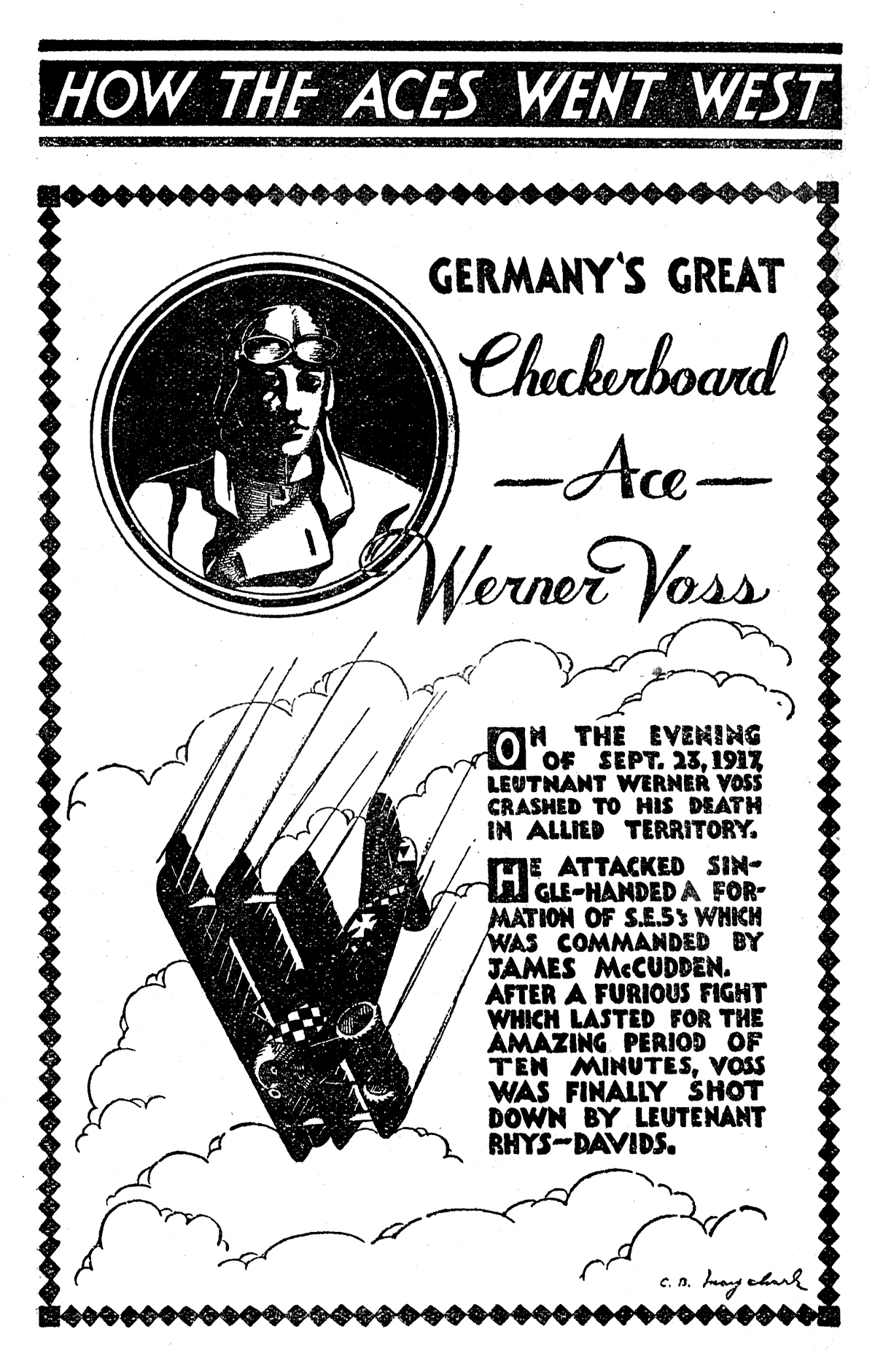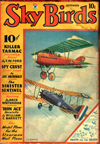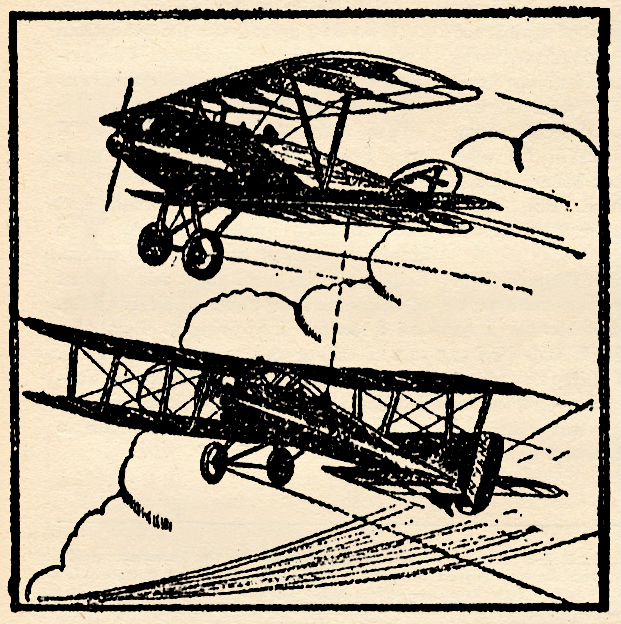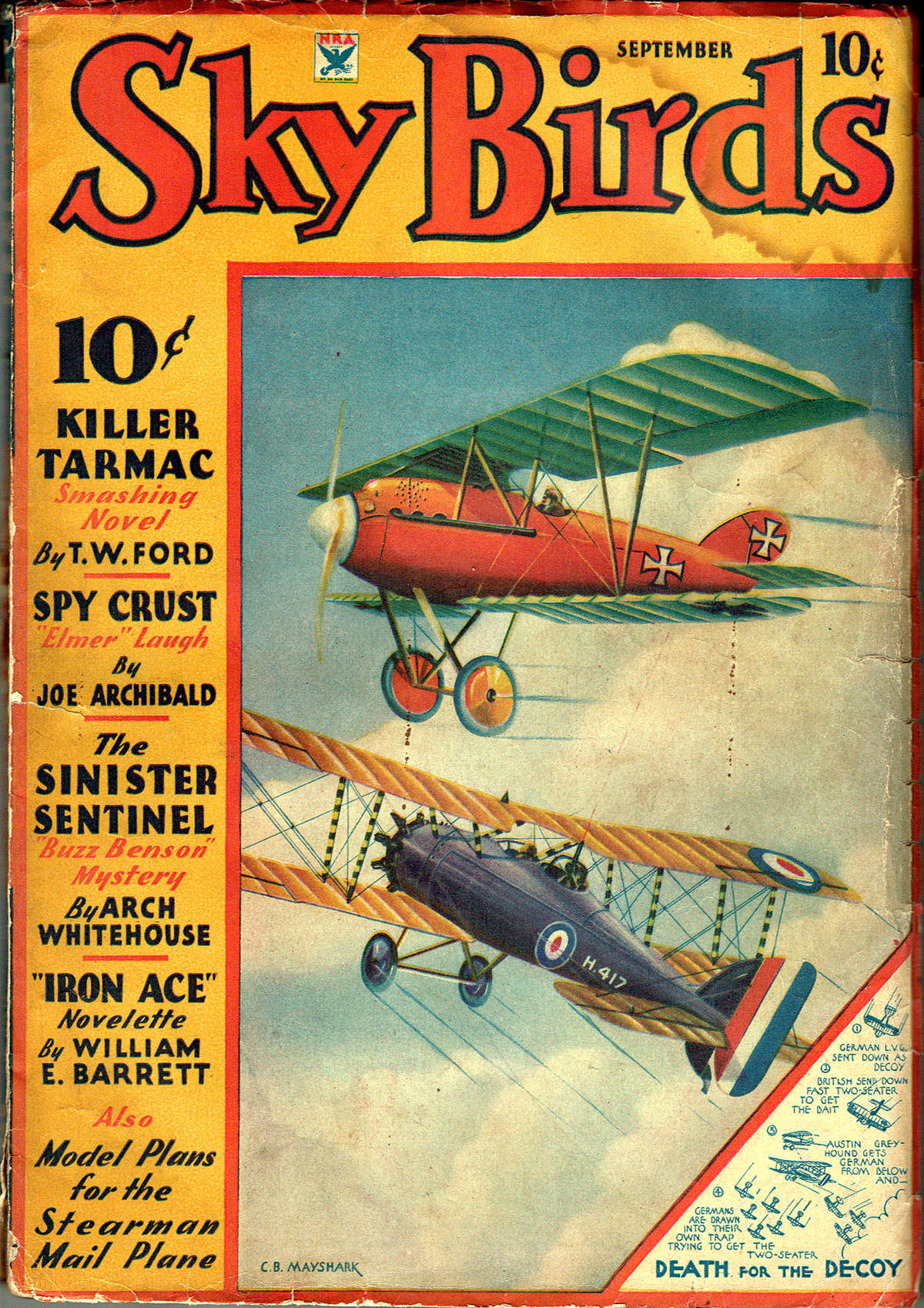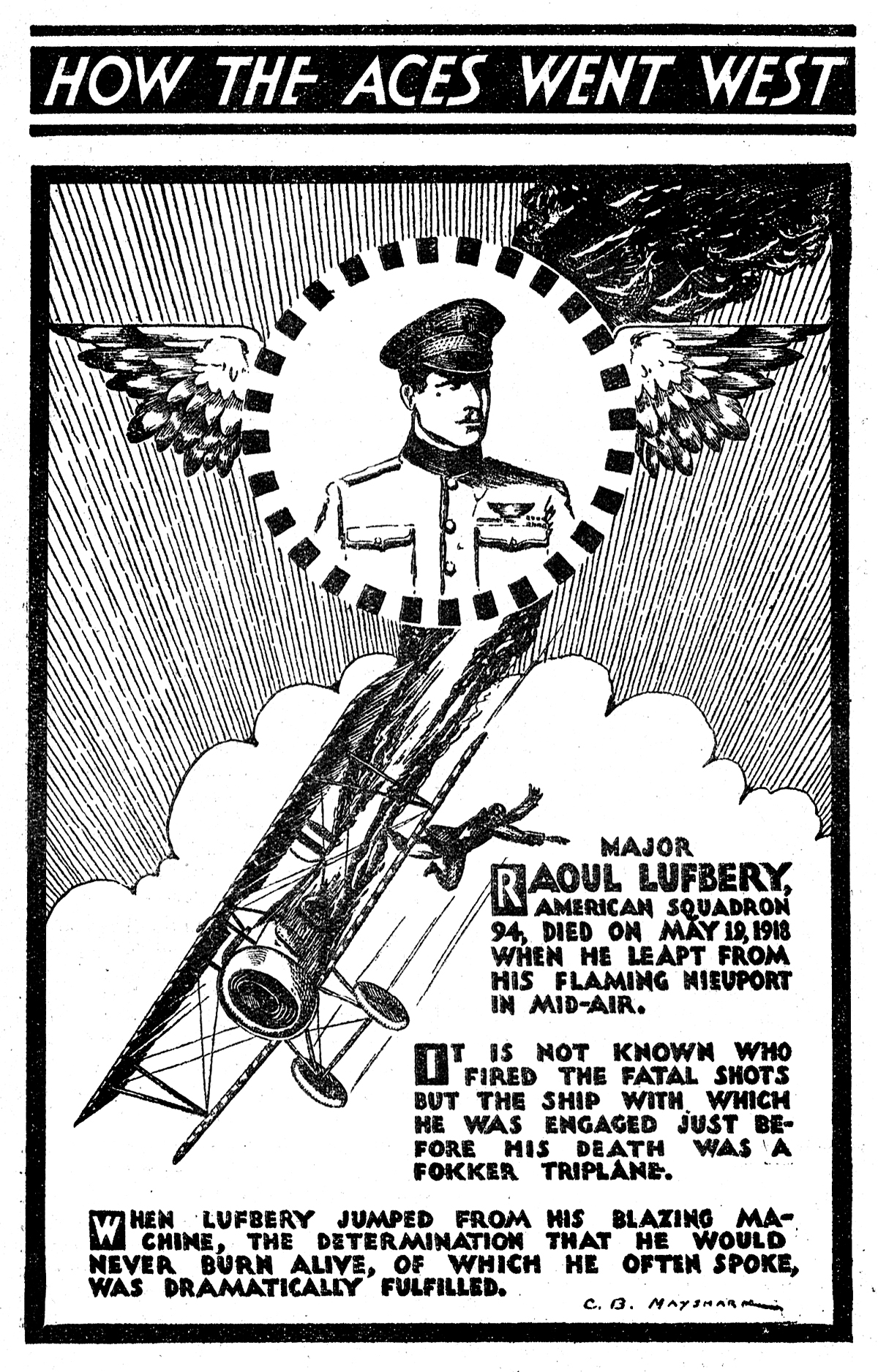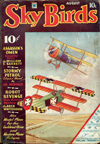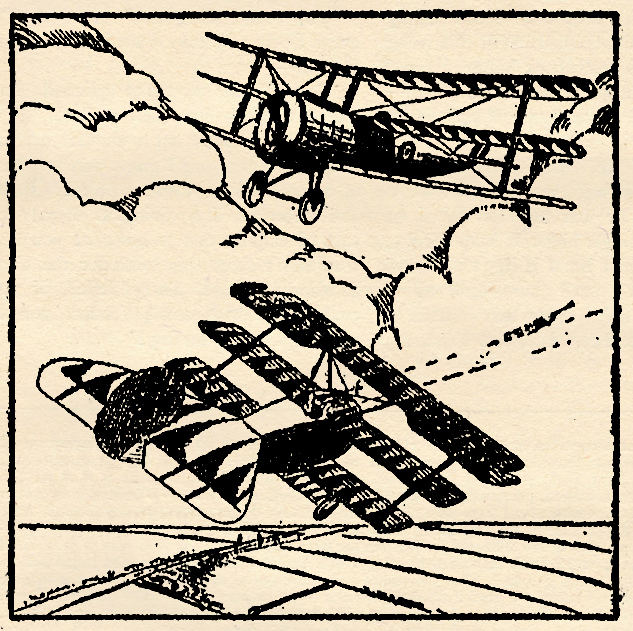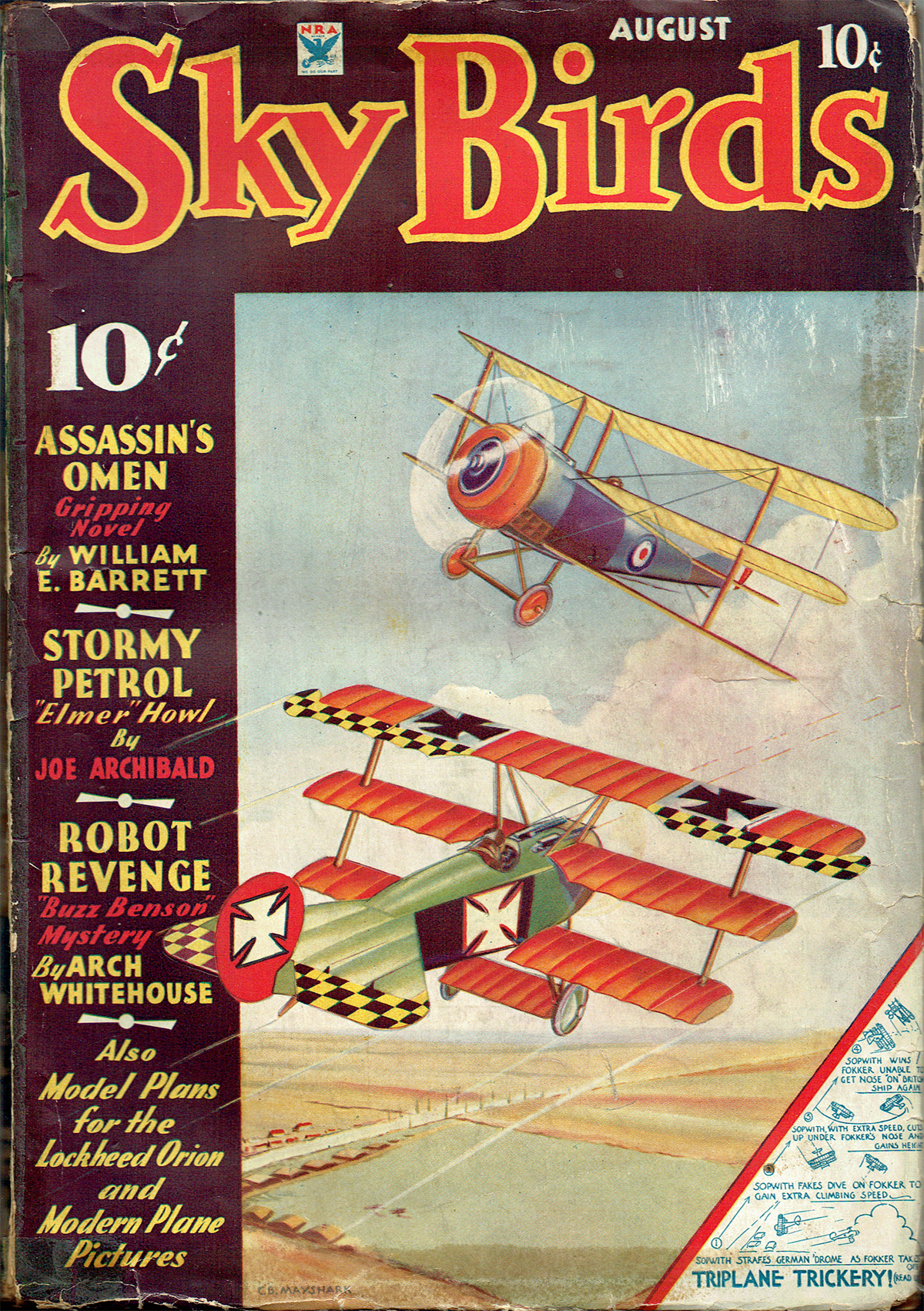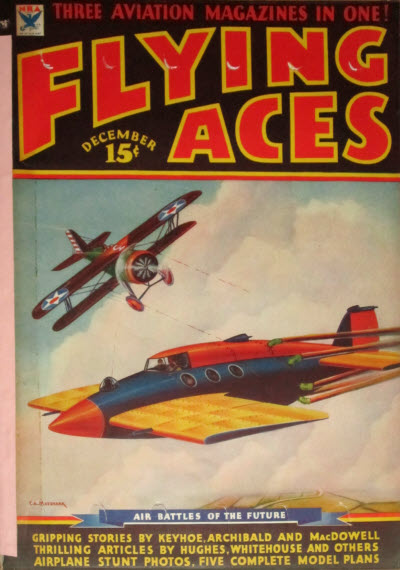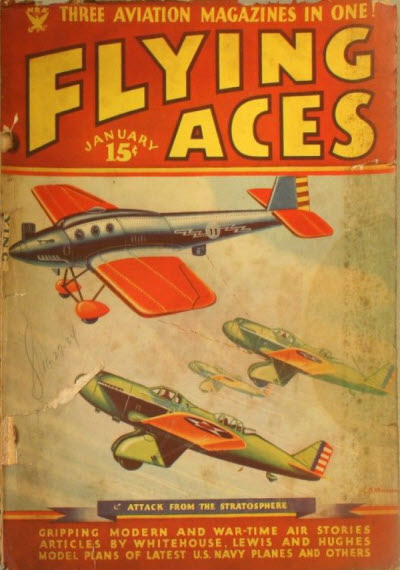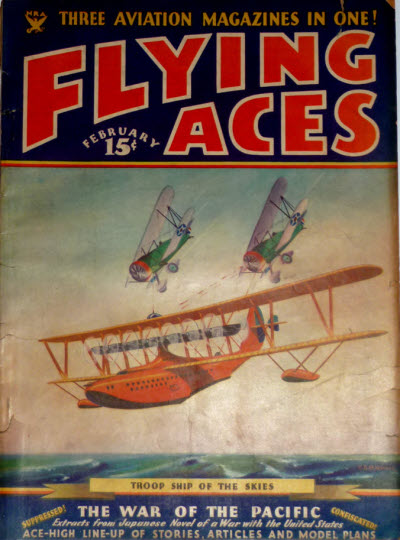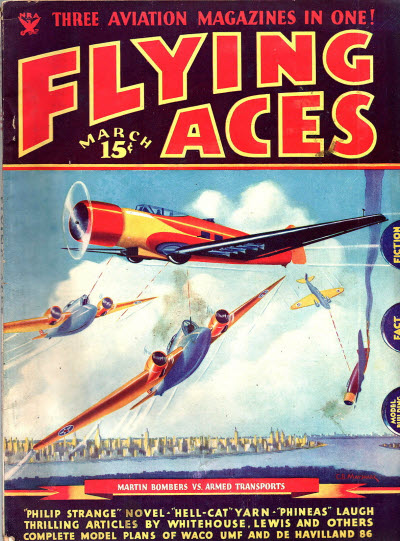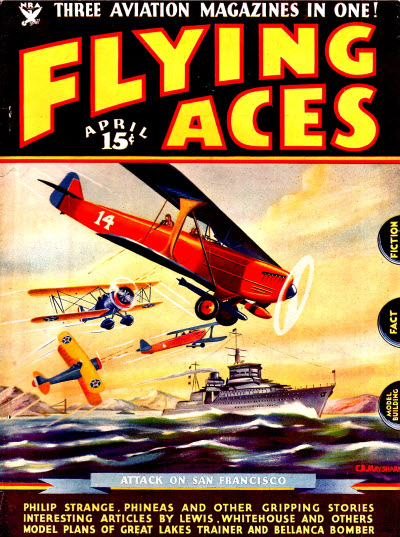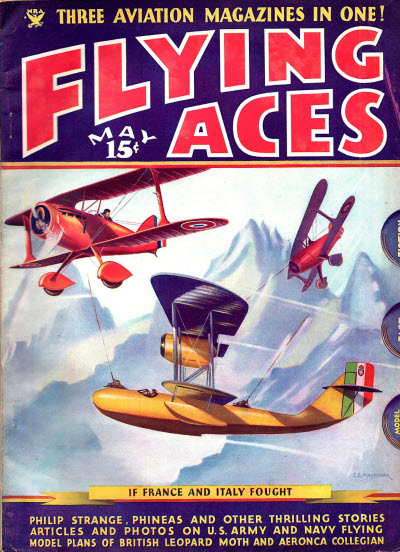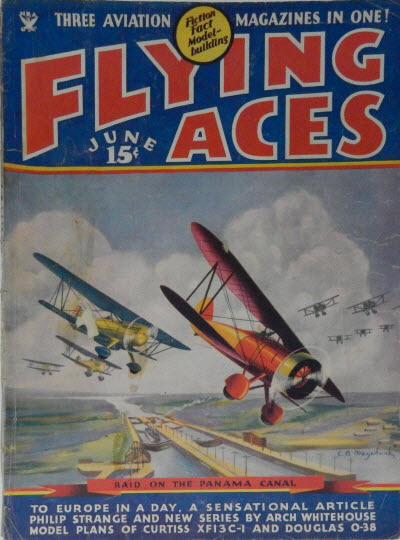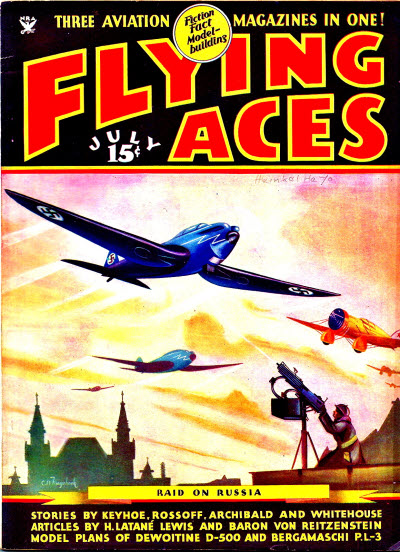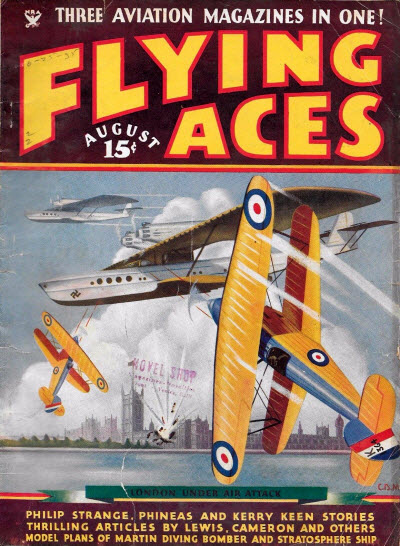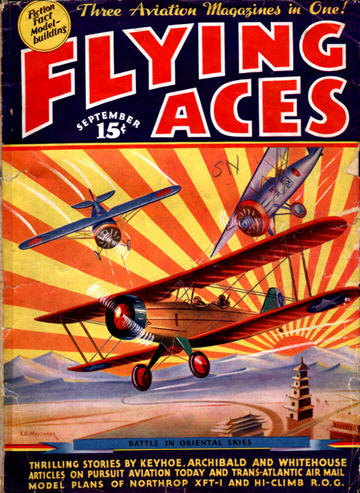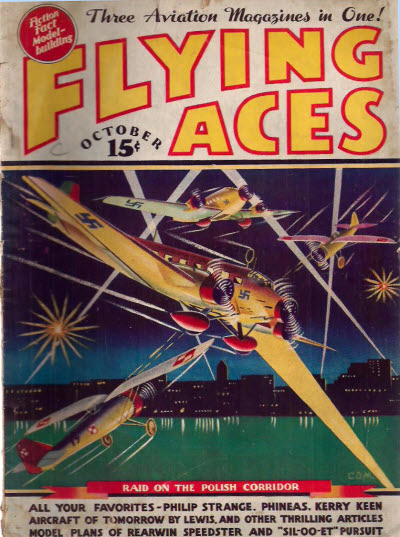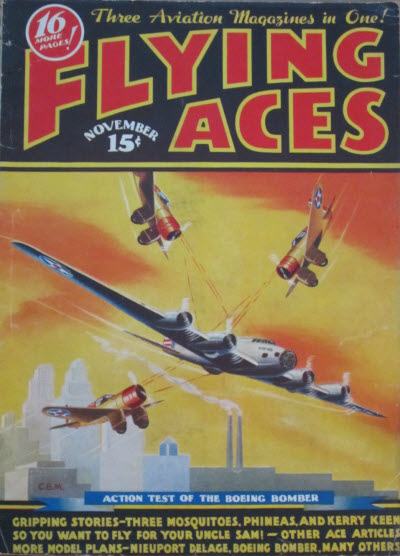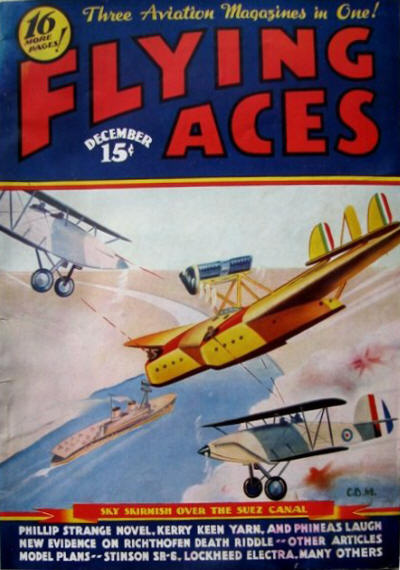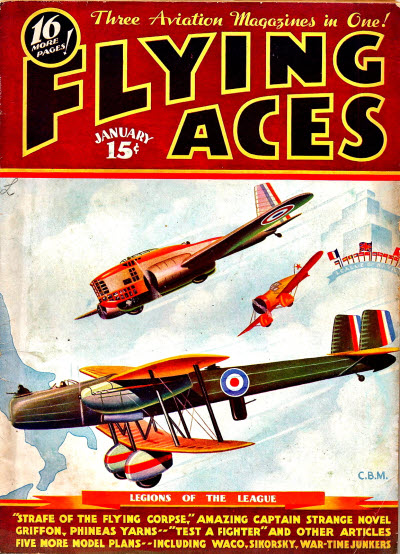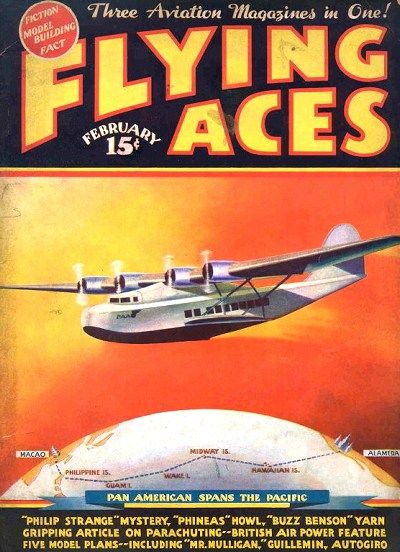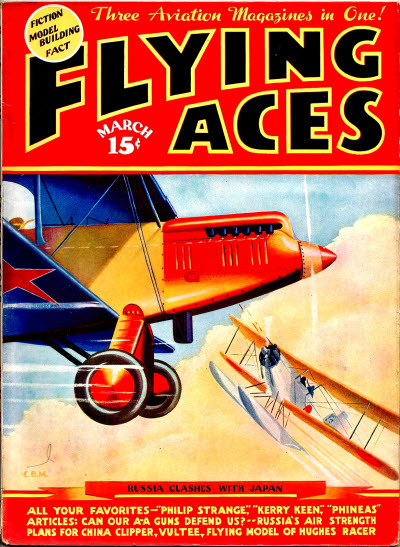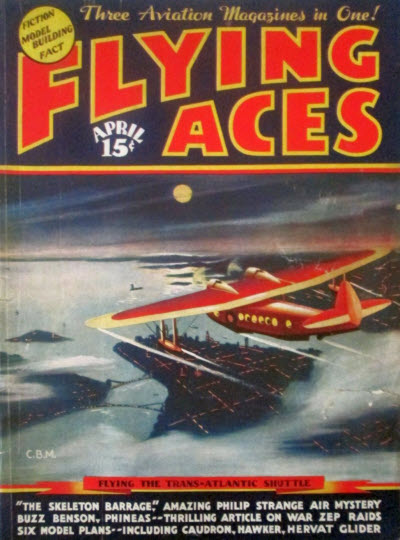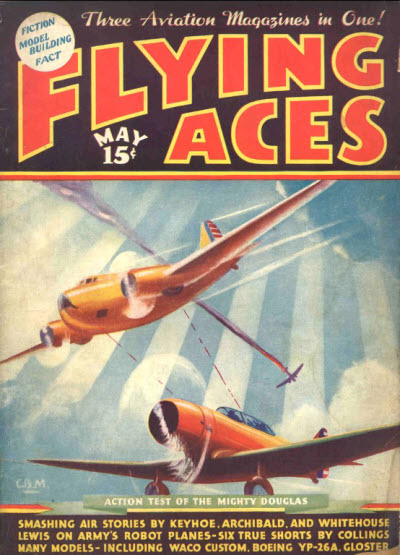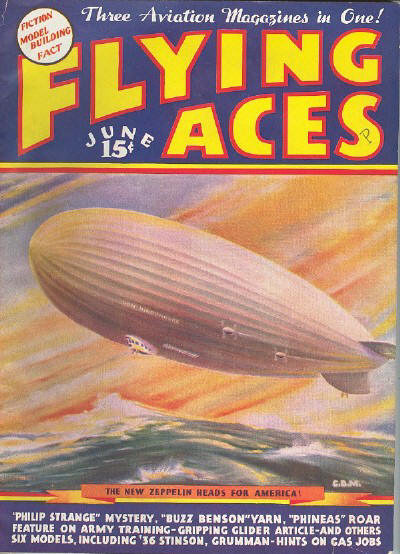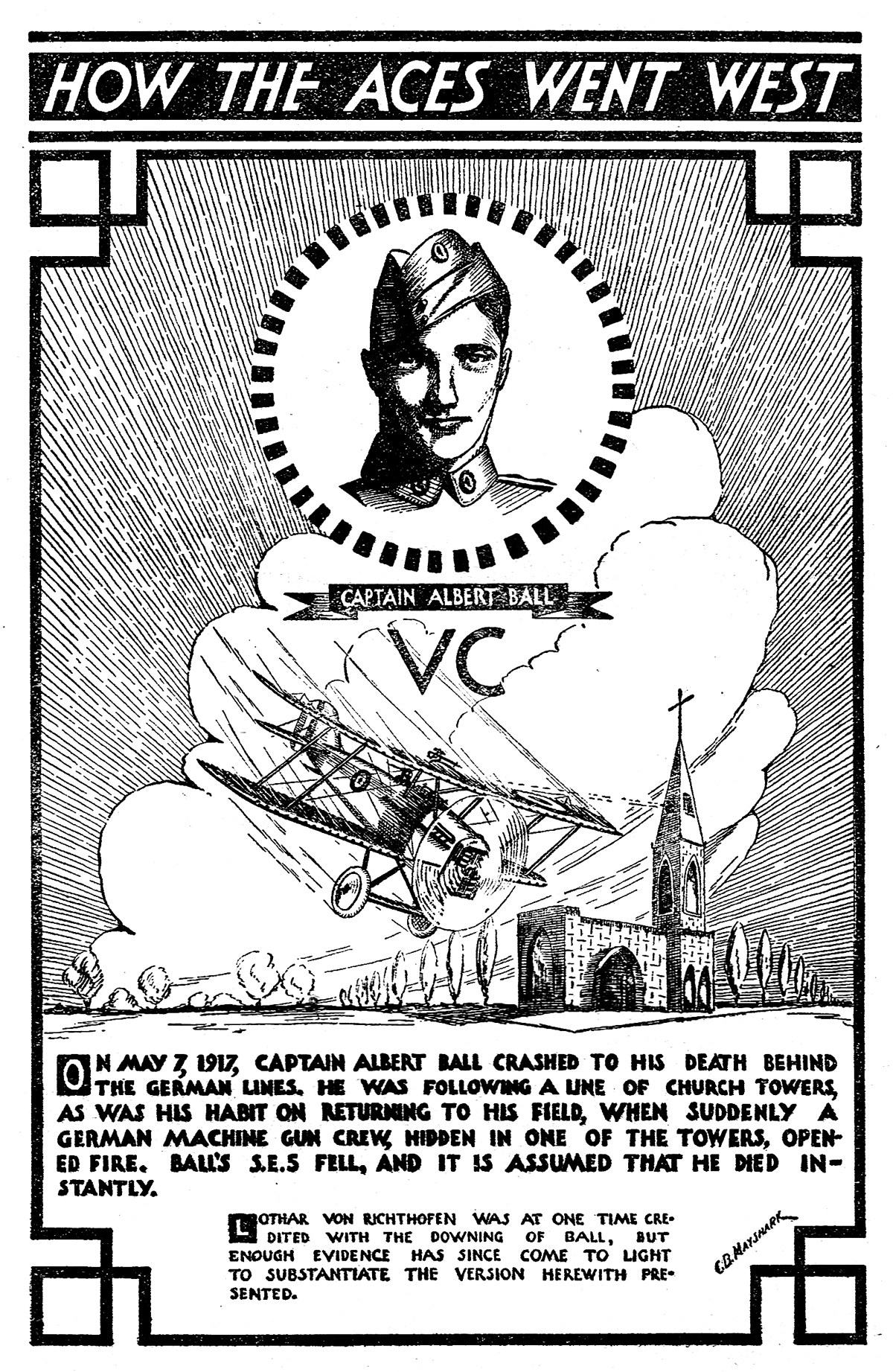THIS May we’re celebrating the genius that is C.B. Mayshark! On Mondays we’ll be exploring his combat maneuver covers he did for Sky Birds in 1934; Wednesdays bring his “How The Aces Went West” feature from 1935 issues of Sky Birds; and Fridays bring his covers from Flying Aces (1934-1936) and a story attributed to him from Dare-Devil Aces!
We featured his first Sky Birds cover yesterday to get the month rolling a day early. Today we have a bio of the man from Age of Aces’ resident art historian, David Saunders. Saunders’ Field Guide to Wild American Pulp Artists is an excellent site profiling any pulp artist and illustrator you can think of. Here is his entry for C.B. Mayshark:

CASIMIR B. MAYSHARK
(1912-1978)
CASIMIR BENTON “DUKE” MAYSHARK was born Casimir Mieczyslaus Mayshark, Jr., on January 3, 1912 in Sacramento, California. His father, Casimir Mieczyslaus Mayshark, was born in 1881 in Poland and came to the U.S. in 1893 and settled in San Francisco, California.
The family name Mayshark is an English transliteration of the Polish name in the Cyrillic alphabet, so U.S. immigration officials had to assign approximate phonetic equivalents. Other members of the same family who came to the U.S. were assigned various names of similar sounds, such as “Maycherczyk,” “Marzajek,” “Majchrzak,” and “Mazureck.”
The father was a commercial artist in the advertising industry of San Francisco. It was the father’s second marriage, the first one having ended unhappily, after he deserted his wife and two sons in Missouri.
The mother, Oreon Gracie Page, was born in 1875 in Mississippi, so she was six years older than her husband. She was also and artist. She designed and decorated Art Nouveau china. It was also her second marriage, the first one having ended after one year, when her husband, Percy Frank Wilson (1878-1906), the city editor of the Memphis News Scimitar, died of typhoid fever on January 15, 1906. After his death she lived with her parents in El Paso, Texas, where she operated a private art school.
In 1908 she advertised her classes in the local newspaper. By 1910 she had moved to Los Angeles, California, where she met and married Casimir Mieczyslaus Mayshark on May 7, 1910. They had two children, Casimir Mieczyslaus Mayshark, Jr., (b.1912), and his younger brother, James Page Mayshark, born June 5, 1913. The family lived at 278 29th Avenue in San Francisco.
On May 25, 1913 The San Francisco Call reported in the Art Notes column by Porter Garnett, “Casimir M. Mayshark has recently shown a landscape at the Bohemian Club. This is the first easel picture that Mr. Mayshark, who has specialized in scenic decoration in European and Eastern theaters, has exhibited here. It arrests the attention immediately by its personal quality, its quietness and its altogether delightful color.”
In 1913 the San Francisco Sketch Club organized a poster contest to commemorate the city’s patron saint, Saint Francis. On November 1, 1913 The San Francisco Call published the results of the contest. Casimir M. Mayshark was listed as an entrant but failed to win the $500 prize, which went to the NYC artist Adolph Treidler (1886-1981).
In 1914 Casimir M. Mayshark, with his wife and two sons, moved to El Paso, Texas, where they lived with the mother’s family and the father worked as a manager of the Tuttle System outdoor advertising agency.
In 1915 Casimir M. Mayshark, with his wife and two sons, moved to the East Coast to pursue his career as a Commercial artist in New York City. The family lived at 24 Van Dyke Place in Summit, New Jersey. The father commuted by ferry boat to NYC, where he worked as a freelance commercial artist.
On September 12, 1918 during the Great War Casimir M. Mayshark registered with the draft board. He listed his occupation as Poster Designer. He was recorded to be of medium height, slender build, with blue eyes and brown hair. He was thirty-six, married and supporting two young sons, so he was not selected for military service.
In 1919 the father deserted the family and was never heard from again. Casimir, Jr., was age seven and James was age six. After the marriage was legally dissolved, Casimir Mieczyslaus Mayshark, Jr., was renamed Casimir Benton Mayshark.
The mother and two sons moved to Chatham, New Jersey, where they lived at 222 Hillside Avenue. She supported the family as a commercial artist designing decorative wall paper for a manufacturer.
The father had moved to Atlantic City, NJ, where he worked as a sign painter.
On September 15, 1920 Casimir M. Mayshark addressed the 11th Annual Convention of the Outdoor Advertising Association, held in Cleveland, Ohio. His lecture topic was “Color in Outdoor Advertising.”
In 1925 Casimir M. Mayshark married his third wife, Jesse Whitney. She was born in 1889 in New Hampshire. They lived with her brother’s family at 54 Turner Street in Boston, Massachusetts, where he worked as an Interior Decorator. They had two children, Cyrus, born August 3, 1926, who grew up to become an author, and Mary, born May 5, 1928, who grew up to become Mrs. Mary Mayshark Perkins.
In 1929 the father, Casimir M. Mayshark, lived with his third wife and two children at 54 Conant Street in Roxbury, MA, but the following year he again deserted his third wife and two children, after which that marriage was legally dissolved.
In June of 1930 Casimir Benton “Duke” Mayshark graduated from Chatham High School. He had always liked to draw, but by high school he had become interested in a career as a commercial artist.
In 1931 he attended the University of Alabama, where he completed his freshman year. The Great Depression brought hard times to most American families, which made college difficult to afford. By 1932 his younger brother, James Mayshark, had graduated high school with a promising record in football and a dream to play in college, so Casimir Benton “Duke” Mayshark entered the work force instead of returning to Alabama after his freshman year. His brother became a star player with the Mountain Hawks of Lehigh University in Bethlehem, PA.
In 1932 C. B. Mayshark began to work as a commercial artist in NYC publishing and advertising. He attended night school art classes at the Art Students League at 215 West 57th Street, where his best teacher was Morris Kantor (1896-1974).
In 1934 C. B. Mayshark painted covers for the pulp magazines Sky Birds and Flying Aces. He also drew pen-and-ink interior story illustrations for these two titles. In addition, he wrote several descriptive articles about his cover paintings, which were featured inside the magazines. He signed his work for pulp magazines “C. B. Mayshark” and “C.B.M.”
The 1940 NYC Business Directory listed the art studio of C. B. Mayshark at 15 West 51st Street, between Fifth and Sixth Avenues.
In 1941 he was hired as a staff artist at the James M. Mathes Advertising Company in the prestigious Chanin Building, at 122 East 42nd Street, where Street & Smith, Ideal Publishing, and Decker Publications also had offices. While working at the advertising company he met Helen Lucille Dunaway. She was born December 30, 1919 in Yonkers, New York, and was a graduate of Smith College. She worked as a clerical secretary at J. M. Mathes.
By 1941 his estranged father, Casimir M. Mayshark, had moved to San Diego, California, where he worked as a draftsman for the Simpson Construction Company at the San Diego Naval Training Station. He lived in a lodging house at 432 F Street.
In 1943 Casimir Benton Mayshark was drafted. Before entering service he married Helen Lucille Dunaway. They eventually had three children, Joseph (b.1944), Cassandra (b.1946), and Sanford (b.1951). The family lived in Forest Hills, Queens, NY.
During WWII C. B. Mayshark served as a Second Lieutenant in the Army Air Corps, 17th Bomber Wing, Second Air Corps, Radio Division. He was stationed at an air base in Idaho, where he painted a mural in Building 23 of the air base. He was not sent overseas.
His younger brother, James P. Mayshark, served as a Captain in the Army Tank Corps and was wounded in North Africa.
On 1943 nationwide newspapers covered the poignant story of his mother, Mrs. Oreon Page Mayshark, and her remarkable experience as she sat in a Times Square movie theater and watched a wartime newsreel with dramatic battle scenes, and suddenly recognized her son as he was wounded in combat.
After the war, C. B. “Duke” Mayshark started Mayshark & Keyes Advertising Art Company with a partner, Bill Keyes. The company grew successful during the post-war years.
His brother, James P. Mayshark, became a salesman of Pneumatic tools and moved to Buffalo, NY.
In 1950 C. B. Mayshark sold his share in the business to his partner and retired to Santa Fe, New Mexico, where he designed and build the family home.
In 1952 he was appointed Director of the New Mexico State Tourist Bureau, of the State Department of Development, under Governor Ed Mechem.
In 1954 that political appointment ended, after which C. B. Mayshark started Mayshark Lithographing Company, which printed jobs for the public, but also won contracts to print posters for the New Mexico State Tourism Bureau.
In 1962 Casimir B. Mayshark’s mother, Oreon Gracie Page Mayshark, died at the age of eighty-seven in Santa Fe, where she had lived with the family.
In 1962 C. B. Mayshark closed the printing company when he was appointed Administrative Assistant for New Mexico Governor Jack Campbell.
In 1964 C. B. Mayshark became Executive Secretary to the Governor of New Mexico, in charge of Promotion of Business and Tourism with national advertising campaigns, New Mexico Magazine, and the organization of the New Mexico State Exhibition at the 1964 World’s Fair in NYC.
The father, Casimir Mieczyslaus Mayshark, returned to San Fransisco, where he lived at 715 Clementina Street, and continued to work as a Commercial Artist, until he died at the age of eighty-four on November 5, 1965.
In 1966 C. B. Mayshark was the Director of the New Mexico Department of Development.
In 1968 C. B. Mayshark retired from New Mexico State politics and concentrated on making art. His work was exhibited at the University of New Mexico, St. John’s College in Santa Fe, and the University of Hawaii.
C. B. “Duke” Mayshark (age sixty-six) and his wife, Helen Lucille Mayshark (age fifty-eight), were fatally injured in an automobile accident in Albuquerque, NM, on September 28, 1978.
David Saunders included many photos and illustrations in his entry for C.B. Mayshark on his site. Please check them out and come back frequently this month for more from C.B. Mayshark!
© 2015 David Saunders. David Saunders is the son of pulp artist Norman Saunders and an artist himself. The above article is from David’s website A Field Guide to Wild American Pulp Artists and is used with his kind permission.
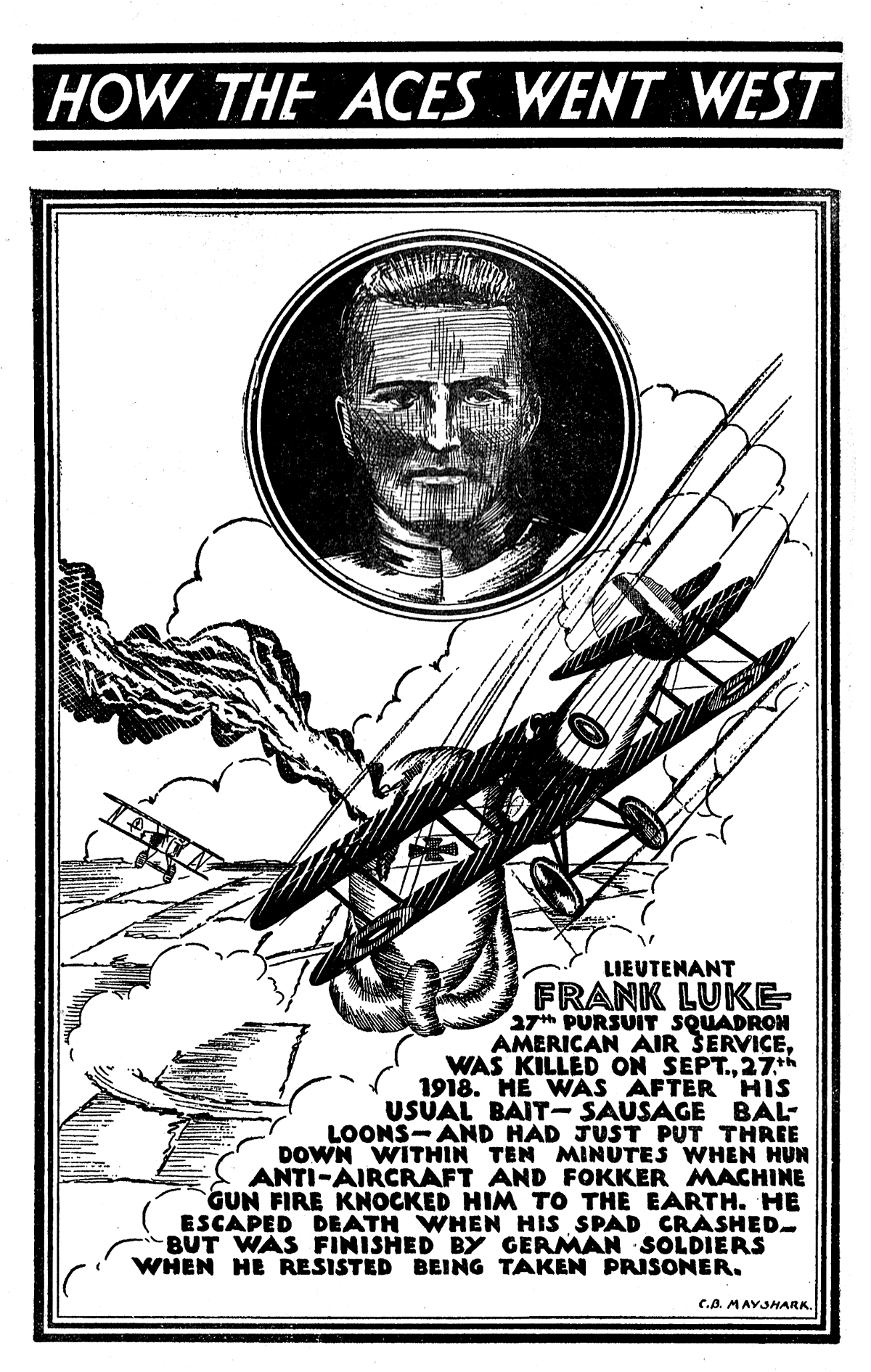





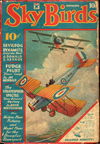
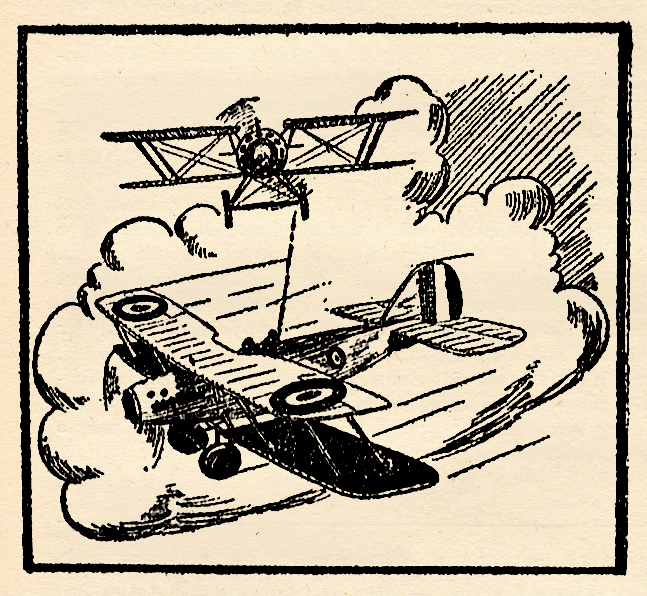
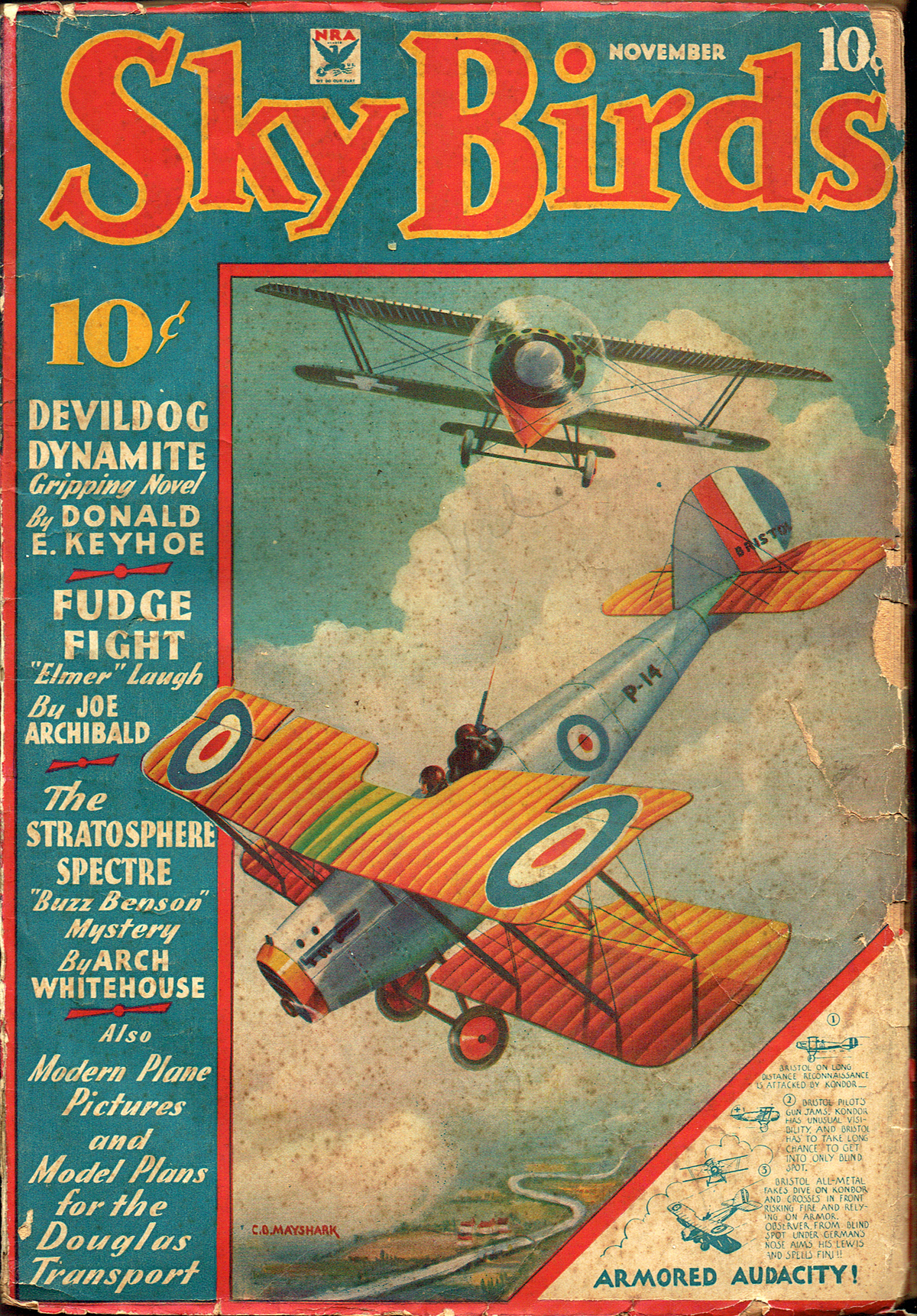
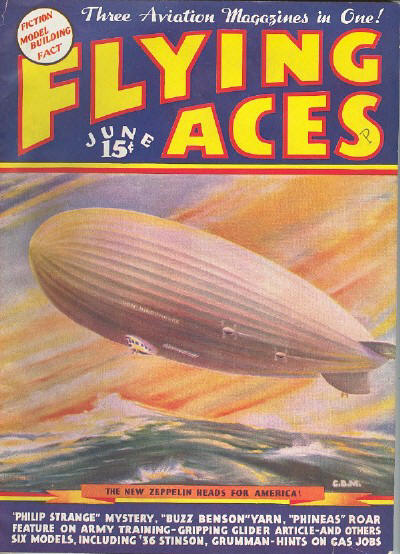 That sound can only mean one thing—that marvel from Boonetown, Iowa is back causing more trouble than he’s worth! That miscreant of Calamity manages believes he has a sure thing goin’, but overplays his hand andgets not only himself in hick, but practiaclly the whole of the Ninth including the Old Man! It’s a case of “cash-and-miscarry” ala Carbuncle in “Sky Finance” from the pages of the June 1936 Flying Aces!
That sound can only mean one thing—that marvel from Boonetown, Iowa is back causing more trouble than he’s worth! That miscreant of Calamity manages believes he has a sure thing goin’, but overplays his hand andgets not only himself in hick, but practiaclly the whole of the Ninth including the Old Man! It’s a case of “cash-and-miscarry” ala Carbuncle in “Sky Finance” from the pages of the June 1936 Flying Aces!
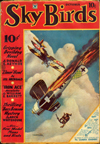


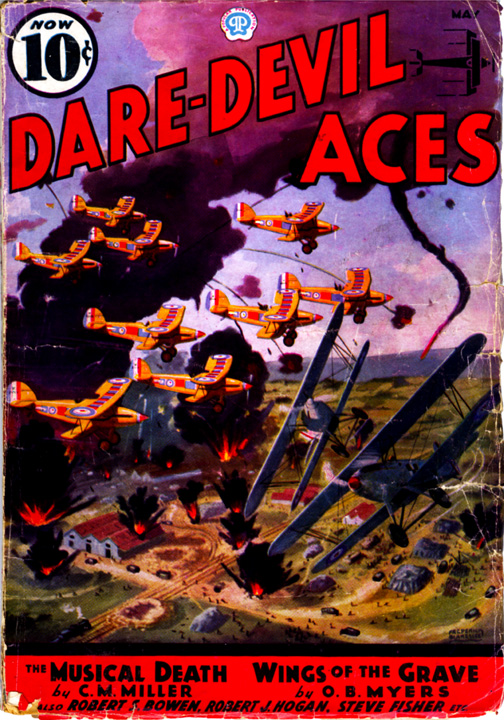 posts we have a rare story
posts we have a rare story 